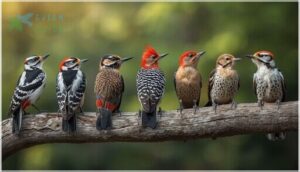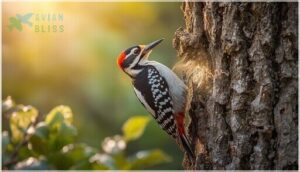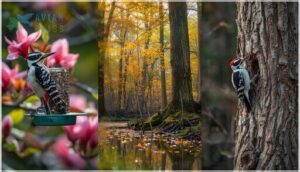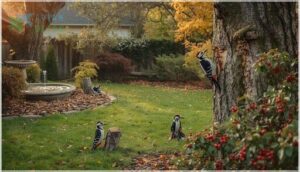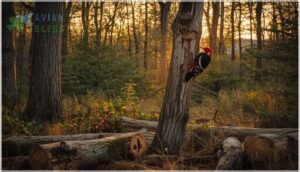This site is supported by our readers. We may earn a commission, at no cost to you, if you purchase through links.
The drumming you hear echoing through Delaware’s woodlands isn’t random noise—it’s a carefully orchestrated territorial announcement that can reveal exactly which woodpecker species is nearby. Delaware hosts seven distinct woodpecker species, from the palm-sized Downy Woodpecker to the crow-sized Pileated Woodpecker, each with unique plumage patterns and behaviors that make identification surprisingly straightforward once you know what to look for.
Whether you’re spotting these birds in mature forests near Brandywine Creek State Park or trying to attract them to your backyard feeder, understanding their habitat preferences and food requirements transforms casual birdwatching into confident species recognition.
Learning to distinguish between the Hairy and Downy Woodpeckers or recognizing the Red-bellied Woodpecker’s distinctive call opens up a whole new dimension of your local ecosystem.
Table Of Contents
- Key Takeaways
- Woodpecker Species Found in Delaware
- Identifying Delaware’s Woodpeckers
- Woodpecker Habitats Across Delaware
- Attracting Woodpeckers to Your Yard
- Conservation of Delaware’s Woodpeckers
- Frequently Asked Questions (FAQs)
- What are woodpeckers mating behaviors in Delaware?
- Do woodpeckers create holes in residential properties?
- How does climate change impact Delawares woodpeckers?
- What are woodpeckers main predators in Delaware?
- Are there any woodpecker festivals in Delaware?
- What time of year do woodpeckers breed in Delaware?
- Can woodpeckers damage my home or trees?
- How long do Delaware woodpeckers typically live?
- Do woodpeckers migrate or stay year-round in Delaware?
- What predators threaten woodpeckers in Delaware?
- Conclusion
Key Takeaways
- Delaware hosts seven distinct woodpecker species ranging from the tiny Downy Woodpecker (9.3 mm bill) to the crow-sized Pileated Woodpecker (50 mm bill), each identifiable through unique plumage patterns, drumming speeds, and vocalizations.
- You can attract woodpeckers to your yard by offering suet feeders (which boost winter visits by 62%), planting native species like oaks and serviceberries, and preserving dead trees that provide essential cavity nesting sites.
- While most Delaware woodpeckers stay year-round, habitat loss has reduced nesting cavity availability by 11% and insect populations by 10-20%, threatening species like the Red-headed Woodpecker despite gains in suburban-adapted populations.
- Woodpeckers drum at species-specific rates—Downy Woodpeckers at 20-25 strokes per second versus Pileated Woodpeckers’ powerful 2-5 second bursts—making their territorial drumming a reliable identification tool before you even see the bird.
Woodpecker Species Found in Delaware
Delaware is home to a surprising variety of woodpeckers, each with its own quirks and favorite haunts. You might spot some right in your backyard or hear them calling in the woods.
Let’s walk through the seven species you’re most likely to find here.
Downy Woodpecker
Let’s start with the Downy Woodpecker—a tiny dynamo, and the smallest of the Woodpecker species in Delaware. You’ll spot these birds using their short bill on tree bark or suet feeders. Their high-pitched calls and soft drumming often echo in backyards.
Hardy and adaptable, Downies thrive in forests, parks, and urban areas, making Backyard Birding easy. Websites, like this one, use cookies to track visitor behavior.
Hairy Woodpecker
Switching gears from the Downy to the Hairy Woodpecker, you’ll notice they’re bigger, with a bill nearly as long as their head—handy for rapid tree tapping.
Hairy Woodpeckers stand out in Delaware’s mixed hardwood forests, favoring mature trees with plenty of dead wood. To guarantee accuracy in identifying them, consider using structured review questions.
Their clear “pik” calls and energetic foraging behavior make them easy to spot, especially for curious birdwatchers.
Red-bellied Woodpecker
Once you spot a Red-bellied Woodpecker in Delaware’s mature forests or cozy suburbs, you’ll see why folks love watching them. Check their barred black-and-white back, pale face, and fiery cap. Their “kir-kir-kir” call rings out, especially as they forage insects in bark. You’ll recognize them through:
- Delaware distribution
- Plumage features
- Unique vocalizations
- Characteristic foraging behavior
Northern Flicker
While Red-bellied Woodpeckers might rule the backyard, the Northern Flicker brings a different energy to Delaware’s edges and open woods. Flicker identification is easiest when you spot their yellow-shafted wings and hear their loud, drumming behavior. Ground foraging habits set them apart from most woodpecker species.
If you’re patient, you’ll notice how their habitat preference shifts with season.
Pileated Woodpecker
When you encounter Delaware’s largest woodpecker species, its dramatic presence is unmistakable. The Pileated Woodpecker stands out through multiple characteristics that aid woodpecker identification:
- Crest identification – Males sport a striking red triangle crest
- Territory size – Pairs defend 1.5–2.5 square kilometers
- Drumming acoustics – Powerful rolls echo at 5–8 taps per second
- Juvenile dispersal – Young birds travel 25–40 kilometers from nests
Their foraging behavior leaves rectangular excavations in mature forest trees.
Yellow-bellied Sapsucker
During late winter migrations, you’ll recognize the Yellow-bellied Sapsucker by its pale yellow breast and distinctive black-and-white striped back. This woodpecker species in Delaware creates vertical sap well patterns in maples and birches, drilling shallow rows to feed on flowing sap.
Their foraging strategies shift toward protein-rich insects during nesting behavior, supporting clutches of 4–7 eggs in excavated snags across northern counties.
Red-headed Woodpecker
You’ll easily identify this striking Woodpecker Species in Delaware by its stunning plumage variations—a fully crimson head contrasts sharply with jet-black wings and snow-white underparts. Redheaded Woodpecker populations favor mature deciduous forests with abundant snags, where their bill morphology suits foraging habits focused on beetles and cached nuts.
Key identification traits include:
- Call identification: Sharp “pik-a-tik” sequences differ from Northern Flicker laughs
- Habitat preferences: Open woodland edges with standing deadwood
- Size: 9–10 inches, larger than Downy but smaller than Pileated Woodpeckers
Identifying Delaware’s Woodpeckers
Spotting a woodpecker isn’t hard in Delaware, but knowing which one you’re looking at can be trickier than you’d think. Each species has its own telltale signs, from the patterns on their feathers to the size of their bill and the sounds they make.
Let’s break down the key features that’ll help you identify these birds with confidence.
Distinctive Plumage and Markings
When you’re learning bird identification, plumage patterns become your best friend. Each woodpecker species in Delaware wears its own signature look. The Downy shows a black-and-white checkered back with a tiny red patch on males, while the Red-bellied sports bold black-and-white bars with a faint reddish belly. Northern Flickers stand out with their brown body and striking white rump that flashes during flight.
| Species | Head Markings | Body Pattern |
|---|---|---|
| Downy Woodpecker | Small red patch (males) | Black-and-white checkered back |
| Red-bellied Woodpecker | Red nape, pale face | Black-and-white barred back |
| Northern Flicker | Brown crown, black bib | Brown body, spotted belly |
The Pileated’s dramatic red crest and white facial stripes make it unmistakable, while the Red-headed’s solid crimson head catches your eye instantly. Yellow-bellied Sapsuckers display pale yellow bellies with distinctive white wing patches. These feather colors and tail features help you nail down types of woodpeckers quickly.
Size and Bill Differences
Size differences can make or break your woodpecker identification. The tiny Downy averages a 9.3 mm bill, while the massive Pileated stretches to 50 mm—that’s five times longer.
Bill length ratios help distinguish tricky pairs: Hairy Woodpeckers show a 0.62 bill-to-head ratio versus Downy’s 0.46. Watch for species size overlap between similar birds, and remember juvenile bill size runs proportionally shorter until maturity.
Unique Calls and Drumming Patterns
Each Delaware woodpecker species has its own signature rhythm. Drumming communication helps you identify who’s in your backyard before you even spot them.
- Downy Woodpeckers drum at 20-25 strokes per second in rapid bursts
- Pileated Woodpeckers produce powerful single-tone patterns lasting 2-5 seconds
- Red-bellied Woodpeckers show distinctive double-tap sequences in 40-60% of events
- Seasonal variations shift drumming intensity, peaking during spring breeding cycles
Urban drumming rates drop 15-25% compared to deep woods, affecting species repertoire and habitat influence on attracting woodpeckers to your yard.
Woodpecker Habitats Across Delaware
If you want to spot woodpeckers in Delaware, knowing where they live makes all the difference. Different species prefer different settings, from deep woods to your own backyard.
Let’s look at the main habitats where you’ll find these birds throughout the state.
Deciduous and Mature Forests
Across Delaware’s deciduous woodlands, you’ll find woodpecker species thriving where mature oaks and maples dominate. Canopy gaps boost insect abundance by roughly 25%, drawing foragers to these productive zones. Snag importance can’t be overstated—standing dead trees support cavity nesting and raise fledgling success by 15–30%.
However, forest fragmentation and fire suppression shift habitat quality, altering woodpecker habitats and bird watching in Delaware’s forest habitats.
Suburban Parks and Backyards
You might be surprised to learn that suburban parks and backyards host just as many woodpeckers as wild forests. Urban wildlife thrives here when you maintain mature suburban trees—yards with diverse native plantings show a 40% higher likelihood of attracting bird watching in Delaware favorites like the Downy Woodpecker. Here’s what draws woodpecker species in Delaware to park landscaping and backyard birds:
- Backyard feeders stocked with suet attract 65% more visits from common species.
- Dead or decaying wood in yard conservation efforts boosts activity by 35%.
- Native oaks and maples provide essential foraging sites for urban wildlife.
Bird feeders become gathering spots where you’ll spot Red-bellied and Hairy Woodpeckers daily.
Seasonal and Migratory Patterns
Beyond the backyard, seasonal rhythms reshape where you’ll encounter woodpeckers across Delaware. Most species stay year-round, but migration timing creates noticeable shifts. Yellow-bellied Sapsuckers pass through during spring (March–May) and fall (September–October), while Northern Flickers show increased activity in late winter. Breeding seasons peak from February through July, with foraging shifts following insect emergence and sap flow—habitat dynamics that serious bird watchers track closely.
| Species | Migration Pattern | Peak Activity Period |
|---|---|---|
| Yellow-bellied Sapsucker | Migratory through Delaware | March–May, September–October |
| Northern Flicker | Partial migrant | January–February influx |
| Downy Woodpecker | Year-round resident | March–May, August–October peaks |
| Pileated Woodpecker | Nomadic within forests | January–April foraging surge |
Attracting Woodpeckers to Your Yard
If you want to turn your backyard into a woodpecker hotspot, you don’t need fancy equipment or a degree in ornithology. A few strategic changes to your yard can make it irresistible to these birds year-round.
Let’s look at the most effective ways to bring Delaware’s woodpeckers right to your doorstep.
Feeder Types and Food Preferences
If you want to see more woodpecker species at your bird feeders, you’ll need to match the menu to their tastes. Backyard birding tips often start with understanding what brings these birds in close. Here’s what works best:
- Suet vs. Seed: Downy and Hairy Woodpeckers visit suet feeders most often—62% of winter sightings happen there.
- Ground Feeding: Northern Flickers prefer low-placed seed mixes near lawns.
- Seasonal Adjustments: Offer more suet in winter, seeds in spring for better results.
- Feeder Placement: Mount feeders 1.5–2 meters high for best access.
- Water Sources: Add birdbaths during hot months to boost visits by 9%.
Mixing suet and sunflower seeds increases species diversity by 24%, helping you spot more woodpecker species during your bird watching sessions.
Native Plants and Shelter
When you plant native species, you’re rolling out a buffet that woodpeckers can’t resist. Research shows specific plants boost your yard’s appeal:
| Plant Type | Benefit for Woodpeckers |
|---|---|
| Allegheny blackberry (20+ stems/100 m²) | Provides cavity nesting sites |
| Eastern red cedar with hardwoods | Increases foraging substrates by 15% |
| Oak species (acorn abundance) | Boosts occupancy rates 22% in mast years |
| Serviceberry and dogwood | Springtime insects improve fledgling survival 8–12% |
Native grasses foster invertebrate communities that feed nestlings, increasing juvenile return rates across Delaware woodpecker habitats.
Creating Safe Nesting Sites
After you’ve set up feeders and planted natives, woodpeckers in Delaware need the right tree cavities to stick around. Downy Woodpeckers favor cavity sizes around 1.5–2.5 inches in diameter, often in deciduous trees.
Mount nest boxes 10–15 feet high with predator guards—they cut predation by 40–60% in urban mosaics. In Delaware’s woodpecker habitats and behavior studies, safe nest height and design directly boost fledging success.
Conservation of Delaware’s Woodpeckers
Protecting Delaware’s woodpeckers means understanding the challenges they face and what you can do to help. While some species are thriving, others are experiencing declining populations due to habitat loss and environmental changes.
Let’s look at the key threats, practical ways you can support local woodpeckers, and conservation efforts making a difference in your area.
Threats and Habitat Loss
You’re watching Delaware’s woodpeckers struggle as forest cover reduction reshapes their world. Nesting site scarcity has intensified, with cavity availability dropping 11% since selective logging accelerated.
Delaware’s woodpeckers are losing ground as forest loss reduces nesting cavities by 11% and selective logging reshapes their habitats
Food resource decline—particularly a 10–20% drop in insect populations—compounds these habitat loss challenges.
Population trend impacts vary by species, though conservation policy effects show promise where forest ecosystems receive targeted protection. Wildlife conservation and woodpecker conservation remain urgent as these pressures mount.
Supporting Local Woodpecker Populations
You can make a real difference in Delaware’s woodpecker conservation through habitat restoration and ecosystem management efforts. Long-term monitoring shows Downy Woodpecker populations rose 12% in rural areas, while connected green spaces boost Red-bellied and Northern Flicker numbers by up to 20%.
Bird feeders, native plantings, and preserving dead trees create bird-friendly gardens that support wildlife preservation right in your neighborhood.
Conservation Initiatives and Citizen Actions
You can join Delaware’s growing conservation efforts—volunteer monitoring participation jumped 12% in five years, documenting key nesting activity in protected forests. Citizen engagement drives real wildlife management results through:
- Joining habitat restoration projects that increased by 15% across the Mid-Atlantic
- Participating in community planting programs that expanded canopy cover by 4.5%
- Installing bird feeders and nest boxes (2,300+ distributed since 2019)
- Supporting bird conservation through wildlife watch programs
Frequently Asked Questions (FAQs)
What are woodpeckers mating behaviors in Delaware?
Courtship rituals among Delaware’s woodpeckers include drumming displays, mutual preening, and cavity excavation that strengthen pair bonding.
Seasonal timing peaks February through April, while urban adaptations allow nesting habits to persist in suburban habitats.
Do woodpeckers create holes in residential properties?
A homeowner noticed three fresh cavities in their cedar siding last spring. Woodpeckers create holes in residential properties, affecting 2-5% of Delaware homes annually.
Pileated and Hairy Woodpeckers cause most residential risks through property damage to exterior wood.
How does climate change impact Delawares woodpeckers?
Climate change is driving range shifts northward for species like Red-bellied Woodpeckers in Delaware, altering insect dynamics and breeding success.
Habitat changes and conservation needs grow urgent as ecological balance shifts.
What are woodpeckers main predators in Delaware?
Hawks, snakes, and raccoons are Delaware’s primary woodpecker predators. Cooper’s hawks target adults, while rat snakes raid cavities. Raccoons cause significant nest losses, especially in fragmented habitats near residential areas.
Are there any woodpecker festivals in Delaware?
While Delaware doesn’t host dedicated woodpecker festivals, you’ll find them featured in seasonal birdwatching events through partner organizations like the Delaware Ornithological Society, drawing wildlife enthusiasts to regional festivals celebrating bird species statewide.
What time of year do woodpeckers breed in Delaware?
Most woodpeckers in Delaware breed from late March through May. Food availability and regional variations influence nesting seasonality, with breeding success closely tied to climate influence on habitat and migration patterns across Delaware’s diverse avian behavior landscapes.
Can woodpeckers damage my home or trees?
They’re nature’s helpers, yet sometimes trouble-makers. Woodpeckers can cause structural damage to siding and trees, particularly during breeding season. Pileated and red-headed species create larger cavities.
However, mitigation strategies like barriers and tree health management help protect your property.
How long do Delaware woodpeckers typically live?
Most species live between 2 and 12 years in the wild, though bird banding records show maximum longevity reaching 15 years for Hairy Woodpeckers. Average lifespan varies by species and habitat quality.
Do woodpeckers migrate or stay year-round in Delaware?
Most species stay year-round in Delaware, though Northern Flickers and Yellow-bellied Sapsuckers show partial migration.
Urban adaptations and climate impacts influence winter survival, with some populations moving short distances during harsh weather conditions.
What predators threaten woodpeckers in Delaware?
From shadowy owls to nimble snakes, Delaware’s woodpeckers face a gauntlet of threats. Owl predation, snake threats, and squirrel interference top the list, while avian competitors intensify pressure—habitat effects ultimately determine survival in Delaware’s forest ecosystems.
Conclusion
Here’s a fascinating fact: woodpeckers drum up to 20 times per second without getting concussions, thanks to specialized skull adaptations.
Now that you can identify the woodpeckers of Delaware by sight and sound, you’re equipped to appreciate these noteworthy birds in your own backyard. Set up your suet feeders, leave those dead trees standing, and listen closely—you might discover you’ve been sharing your neighborhood with crow-sized Pileated Woodpeckers all along.


